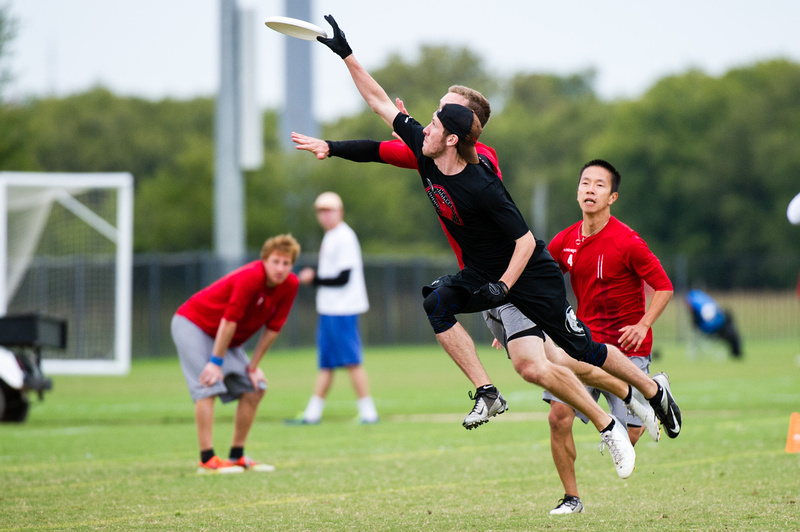 UltiPhotos.com" />
Jeff Bell - UltiPhotos.com
UltiPhotos.com" />
Jeff Bell - UltiPhotos.com
With the advent of the professional leagues, the high cost of playing club ultimate has once again been thrust into the forefront of ultimate discussion. The USA Ultimate championship series, played at the top level, can be very expensive.
Last year, Revolver released their 2012 season expenses in an article that highlighted the realities of how costly it can be to play ultimate for an amateur athlete.
I plan to go one step further by breaking down my personal budget, expenses, and the cost of the Sockeye season to see what it takes financially to play.
Putting my personal information out to the public is a bit scary. Here are reasons I feel like it’s the right thing to do:
1. It’s a worthwhile story.
2. It may allow others to open up to share their own financial struggles to play. I would be curious to see a current college player’s budget or an international club player’s budget.
3. The awareness of this issue is important to me.
My season starts in April and ends mid-October, so long as Sockeye qualifies for nationals. The season is long due to early training for injury prevention, annual tryouts, tournaments spread out from June to October, and necessary team development. 23 weeks out of season, 29 weeks in season.
Occupation: I work full time in a residential facility for children with PTSD as a “Behavior Specialist.” I help these kids through day to day routines in a therapeutic environment to help normalize and stabilize their own behavior. In 2013, I earned $24,000 after taxes.
Living expenses: $14,204
Rent – $650/month (includes utilities), $7,800/year
I currently live in Shoreline, Washington, just outside of Seattle where rent is actually cheaper than in the city. If you ask anyone who lives in Seattle, they will tell you their rent is higher than $650.
Transportation (gas) – $15 per week out of season, $25 per week in season. $1074 for the year.
Food – $80 per week out of season, $110 in season. $5,030 for the year.
Clothes – $300 per year. I don’t shop much and our Patagonia sponsorship keeps me normal looking…sorta. Once a week I wear Sockeye gear/costumes to work.
Sockeye predicted expenses:
Worlds – $2,969.27
USA Ultimate Club Season – $1,991.67
Total: $4,961.29
A detailed breakdown can be found in the table below:
| Overhead | Tryouts | US Open | WUCC | Labor Day | Regionals | Nationals | |
|---|---|---|---|---|---|---|---|
| Number of players | 28 | 28 | 24 | 27 | 24 | 28 | 28 |
| Tournament fee | $25 | $20.83 | $48.49 | $20.83 | $7.14 | $60.71 | |
| Player fee | $15.00 | $243.60 | |||||
| Hotels | $40 | $66.67 | $504.00 | $66.67 | $98.21 | ||
| Flights | $350.00 | $1700.00 | $300.00 | $350.00 | |||
| Ground Transportation | $10.00 | $20.83 | $200.00 | $10.00 | $53.57 | ||
| Field Reservations | $42.86 | ||||||
| Coach Expenses | $178.57 | $16.67 | $77.78 | $16.67 | $17.86 | ||
| Banking Fees | $9.64 | ||||||
| Field Supplies (food, ice, etc.) | $21.43 | ||||||
| Website | $14.29 | ||||||
| Photographer, trainers | $21.43 | ||||||
| General supplies | $7.14 | ||||||
| Team apparel | $80.00 | ||||||
| Cost per player | $375.36 | $90.00 | $485.00 | $2969.27 | $414.17 | $27.14 | $600.36 |
After the above expenses, I have $4,796 left over for entertainment, travel, medical costs, gym, phone, and any emergencies. Needless to say, I do not have a savings account.
When I look at my own budget for the year, it’s hard for me to say that playing for Sockeye is sustainable. Actually, it isn’t.
If it weren’t for teammates who help front money for the team, lend me money personally, or allow me to pay dues later than those who can afford to, I wouldn’t be able to play. It didn’t take me writing my budget out to become aware that the sport is biased towards the upper class, I’ve felt aware since I started playing in high school surrounded by peers in private education, college funds, and the luxury of “traveling across the nation to ultimate tournaments.”
I unfortunately don’t have a solution for sustainability and inclusiveness for lower income players (this includes youth and college), but I do think I am asking the right questions.
What are we doing to prepare youth players to be able to pay for college and travelling tournaments during the college ultimate season?
What are we doing to prepare graduating college players to be able to pay for $5,000 club seasons?
What are we doing to promote localized high level youth competition (USAU’s State Championship model was a great step to helping make the “travelling” hurdle much smaller)?
Are we (elite players) modeling inclusive and financially sustainable behavior?
Is the idea of one right way to play ultimate worth keeping the sport exclusive?
These are compelling questions that need to be asked about where our sport is headed concerning the topics of inclusiveness, financial sustainability and the underserved populations. Nobody is going to ask them unless we all stop treating each other like we all have the money to afford to play.








Comments Policy: At Skyd, we value all legitimate contributions to the discussion of ultimate. However, please ensure your input is respectful. Hateful, slanderous, or disrespectful comments will be deleted. For grammatical, factual, and typographic errors, instead of leaving a comment, please e-mail our editors directly at editors [at] skydmagazine.com.